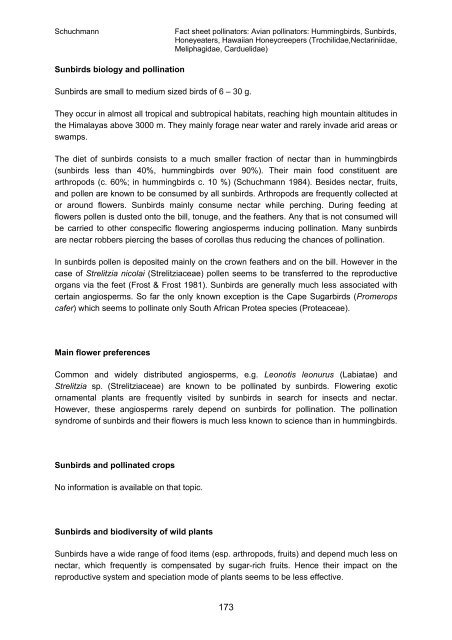Caring for Pollinators - Bundesamt für Naturschutz
Caring for Pollinators - Bundesamt für Naturschutz
Caring for Pollinators - Bundesamt für Naturschutz
You also want an ePaper? Increase the reach of your titles
YUMPU automatically turns print PDFs into web optimized ePapers that Google loves.
Schuchmann Fact sheet pollinators: Avian pollinators: Hummingbirds, Sunbirds,<br />
Honeyeaters, Hawaiian Honeycreepers (Trochilidae,Nectariniidae,<br />
Meliphagidae, Carduelidae)<br />
Sunbirds biology and pollination<br />
Sunbirds are small to medium sized birds of 6 – 30 g.<br />
They occur in almost all tropical and subtropical habitats, reaching high mountain altitudes in<br />
the Himalayas above 3000 m. They mainly <strong>for</strong>age near water and rarely invade arid areas or<br />
swamps.<br />
The diet of sunbirds consists to a much smaller fraction of nectar than in hummingbirds<br />
(sunbirds less than 40%, hummingbirds over 90%). Their main food constituent are<br />
arthropods (c. 60%; in hummingbirds c. 10 %) (Schuchmann 1984). Besides nectar, fruits,<br />
and pollen are known to be consumed by all sunbirds. Arthropods are frequently collected at<br />
or around flowers. Sunbirds mainly consume nectar while perching. During feeding at<br />
flowers pollen is dusted onto the bill, tonuge, and the feathers. Any that is not consumed will<br />
be carried to other conspecific flowering angiosperms inducing pollination. Many sunbirds<br />
are nectar robbers piercing the bases of corollas thus reducing the chances of pollination.<br />
In sunbirds pollen is deposited mainly on the crown feathers and on the bill. However in the<br />
case of Strelitzia nicolai (Strelitziaceae) pollen seems to be transferred to the reproductive<br />
organs via the feet (Frost & Frost 1981). Sunbirds are generally much less associated with<br />
certain angiosperms. So far the only known exception is the Cape Sugarbirds (Promerops<br />
cafer) which seems to pollinate only South African Protea species (Proteaceae).<br />
Main flower preferences<br />
Common and widely distributed angiosperms, e.g. Leonotis leonurus (Labiatae) and<br />
Strelitzia sp. (Strelitziaceae) are known to be pollinated by sunbirds. Flowering exotic<br />
ornamental plants are frequently visited by sunbirds in search <strong>for</strong> insects and nectar.<br />
However, these angiosperms rarely depend on sunbirds <strong>for</strong> pollination. The pollination<br />
syndrome of sunbirds and their flowers is much less known to science than in hummingbirds.<br />
Sunbirds and pollinated crops<br />
No in<strong>for</strong>mation is available on that topic.<br />
Sunbirds and biodiversity of wild plants<br />
Sunbirds have a wide range of food items (esp. arthropods, fruits) and depend much less on<br />
nectar, which frequently is compensated by sugar-rich fruits. Hence their impact on the<br />
reproductive system and speciation mode of plants seems to be less effective.<br />
173

















